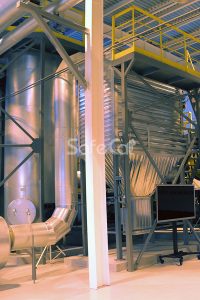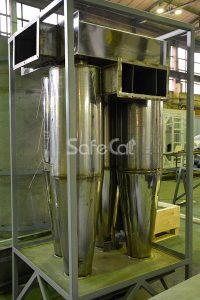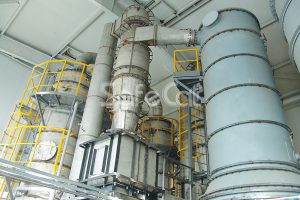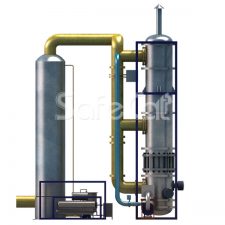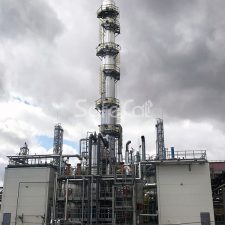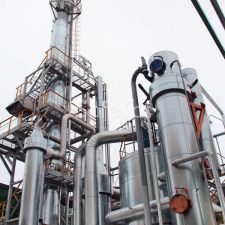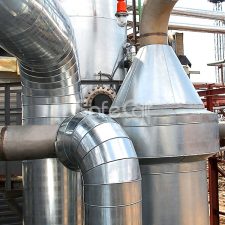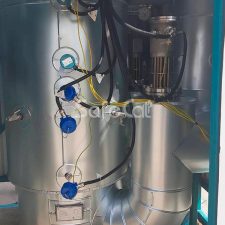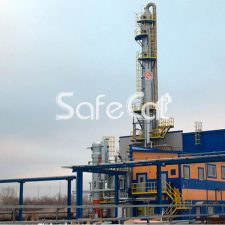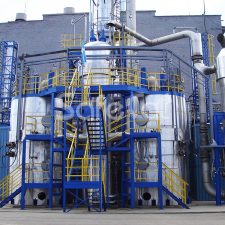Purification of gas emissions as a necessity of the life process
Gas emissions purification became essential for human survival. Any ecosystem has the ability to cleanse itself, but nature is no longer able to cope on its own in terms of technogenic impact as today. Even a small amount of pollutant released into the atmosphere instantly spreads over vast territories and it cannot help but switch this process off. Therefore, more and more attention is paid to the development of support equipment for gas treatment systems, as well as legislation for their application.
The main sources of air pollution are emissions from energy facilities, industrial facilities and transport. Energy and industrial facilities together account for up to 80% of polluting emissions (about 60% – for power engineering and 20% – for industry), for motor vehicles – 20-25%. Thus, a good half of all gas cleaning equipment is designed to deal with combustion products. However, the the emission variety of industrial enterprises by hydrocarbon combustion is not limited and requires in each case special equipment designed and manufactured for a particular process.
The biological and radioactive pollution of the atmosphere also merits mention. These two types account for a rather small percentage of emissions, but their danger is much higher than the average.
The most common pollutants are the following chemical compounds: carbon monoxide, sulfur dioxide, nitrogen oxides, sulfuric acid vapors, often formed in gas ducts during the interaction of sulfur oxides and water vapor. The content of sulfur compounds in gases plays a huge role in the selection of types and equipment of gas purification.
Types of gas cleaning equipment
Gas purification includes two main processes: purification of exhaust gases from suspensions and aerosols and physicochemical purification by neutralizing chemical compounds.
The main gas cleaning methods are listed below:
- absorption (absorption – absorption by volume and adsorption – adsorption by surface);
- chemisorption;
- thermal neutralization, which is divided into technological combustion and catalytic oxidation.
Mechanical cleaning of impurities is also divided into sedimentation, filtration and washing (wet scrubber combines several types of cleaning at once, filtering up to 80% of dust and solid impurities).
Among mechanical cleaning machines bag filters, cyclones and electrostatic filters are most popular.
Cyclone devices are distinguished by a rather low (in terms of modern requirements) degree of purification of a dusty stream. However, they are indispensable as part of an integrated gas treatment system at the preliminary stage, especially if the volumes of gas supplied to the treatment are significant, due to their low cost and ease of maintenance.
Pulse jet bag filters is the most common equipment for cleaning gases from mechanical pollutants. The filter elements do not have a high price, thus positively affecting operating costs. Bag filters favorably differ from cyclones in a high degree of purification, but these are rather complicated devices that require qualified maintenance.
Recently, electrostatic filters have become increasingly common. They lack the main disadvantage of the bag filter: a relatively high flow resistance. Electrostatic filters are large-sized expensive equipment and are designed for large volumes of gas to be purified with a significant initial dust content. Typical applications of electrostatic filters are thermal power plants, waste incinerators, metallurgical production, although a room air ionizer is a close relative of an industrial electrostatic filter.
The role of sulfur compounds in the case of electrostatic precipitators is highlighted: when the sulfur content is less than 1%, the filter efficiency sharply decreases (the border of 1% is rather arbitrary and depends on the humidity of the gases and the content of alkaline components in it). With an increase in sulfur content, not only productivity increases, but also the degree of corrosion. For bag filters, the sulfur content is also critical in terms of the corrosive effect. In the case of a sulfur-containing stream, the gas dew point will always be in the focus of attention of designers of gas purification equipment – the choice of materials and technologies also depends on it.
The electrostatic filter device implies the presence of discharge and pick-up electrodes. A direct current with a voltage of 12–13 kW is supplied to the discharge electrode; the resulting electrical glow ionizes dust particles that are deposited on the pick-up electrodes. Nitrogen can be destroyed with the formation of harmful nitrogen oxides in filters with a voltage of more than 15 kW. Also, in any electrostatic filter, ozone is inevitably generated, which is a powerful oxidizing agent, and at the same time a carcinogen. Electrostatic filters are produced both abroad and in Russia.
Gas purification methods
Absorption gas cleaning methods are diverse and vary depending on the composition of the pollutants. The most common devices are wet and semi-dry scrubbers of various types and adsorbers.
Absorption in a wet scrubber is one of the main gas cleaning methods. It can occur in a wide range of process flow patterns, water can also act as an absorbing liquid (if the solubility in water of the pollutant is high enough and is expressed in hundreds of grams per liter, it is suitable for ammonia, hydrochloric and hydrofluoric vapors), and other compounds. For hydrocarbon compounds, high viscosity oils act as an absorbing medium, and methane is absorbed by liquid nitrogen. Absorption equipment – packed and hollow columns of metal and, today, increasingly, of chemically stable and inexpensive fiberglass.
The absorption method is widely applicable, along with the cleaning of chemical compounds from vapors, the scrubber also performs the function of mechanical cleaning, about 80% of dust and solid impurities leave with drains. The absorbent medium is then supplied for regeneration and, in most cases, can be reused. The main drawback of the absorption method is contaminated effluents of various compositions, which, in turn, require the use of complex technological and expensive processes for regeneration or disposal.
Adsorption (by a dry adsorbent) is also widespread; finely dispersed activated carbon often acts as an adsorbent, which is then disposed of by burning, as well as other materials: alumina, silicon oxide, zeolites, etc. During operation, the adsorbent is irreversibly saturated with a pollutant, and mechanical abrasion occurs.
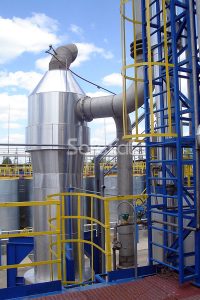 Thermal gas purification methods are divided into technological combustion, thermal oxidation and catalytic oxidation. At least half of the total calorific value are suitable for combustion, processes with a significant calorific value of the exhaust gas. Processes with oxygen deficiency or insufficient calorific value of exhaust gases can have thermal oxidation “on the tail”. It takes place at temperatures up to 800 °C. At this relatively low temperature, the formation of nitrogen oxides does not occur, which favorably distinguishes thermal oxidation from combustion.
Thermal gas purification methods are divided into technological combustion, thermal oxidation and catalytic oxidation. At least half of the total calorific value are suitable for combustion, processes with a significant calorific value of the exhaust gas. Processes with oxygen deficiency or insufficient calorific value of exhaust gases can have thermal oxidation “on the tail”. It takes place at temperatures up to 800 °C. At this relatively low temperature, the formation of nitrogen oxides does not occur, which favorably distinguishes thermal oxidation from combustion.
However, catalytic oxidation became the most widely used method.
Catalytic oxidation occurs on the surface of the catalyst, usually a thin layer of precious metal deposited on a ceramic or fiberglass neutral heat-resistant base. The oxidation reaction proceeds at a temperature significantly lower than that of thermal oxidation – 300-500 °C. In addition, the reaction rate is increasing, which reduces the size of the catalytic reactor. Catalytic oxidation converters are an integral part of the process from the automotive industry to chemical plants.
SC Platinum Based Catalyst: Innovative Catalytic Gas Treatment System
Safe Technologies Industrial Group, together with the Boreskov Institute of Catalysis has developed its low-selective catalyst for the catalytic oxidation of hydrocarbon compounds.. Putting it on a fiberglass, rather than a traditional ceramic base, made it possible to achieve much better mechanical properties and increased tolerance to peak temperatures.
Zirconia-silicate fibers of the catalyst base are able to withstand short-term temperatures of up to 1000°C, without collapsing and without losing operating properties. The catalyst contains an ultra-small amount of precious metal – platinum, and contributes to the oxidation of a wide range of organic pollutants. First of all, it is designed for VOCs (volatile organic compounds). Nominal invulnerability to conventional catalytic poisons (sulfur, silicon) was managed to be achieved due to the catalyst molecules penetration to the tissue to a depth of 10 nm and the absence of contact of the catalytic poisons with the active core. This catalyst is already operating in Lithuanian formaldehyde production concern ACHEMA, where it is set to “tail” of the process, before discharge to atmosphere of excess gas. Purification rates are above 99.8%.
However, the range of capabilities of the Safe Technologies in the field of gas purification is much wider. Along with catalytic oxidation systems, ST IG manufactures thermal treatment systems. The company offers chemisorption and adsorption gas treatment systems. Own production sites of the Safe Technologies creates flexible customizable integrated industrial gas purification solutions that combine several of these technologies at once.
The models range of gas cleaning equipment is presented at the SC Catalytic Plants Catalog. The specialists of ST IG will answer all questions related to the treatment of gas emissions and will help to choose the best solution adapted to the needs of a particular facility.
When using the material/any part of it (media content), a reference to authorship and the site (https://safecat.ru/en) is required.
All equipment presented in the article was manufactured at the production facilities of Safe Technologies.

